When visiting New Hampshire for the first time, some people head to Mount Washington, the highest peak in northeast America. There, you’ll be overlooking the expansive vista of the beautiful White Mountains. Some people also drop by Mount Washington State Park to watch birds in their original habitats.
And although New Hampshire is a relatively small state, over 300 bird species call it home, making it one of the best destinations for avid bird watchers to take extra time to find their favorites. New Hampshire also has all sorts of habitats for birds to choose from.
In this article, I’ll detail all of the species of hawk in New Hampshire, explain where you can find them, how to identify them, and when is the best time to go searching.
Northern Goshawk
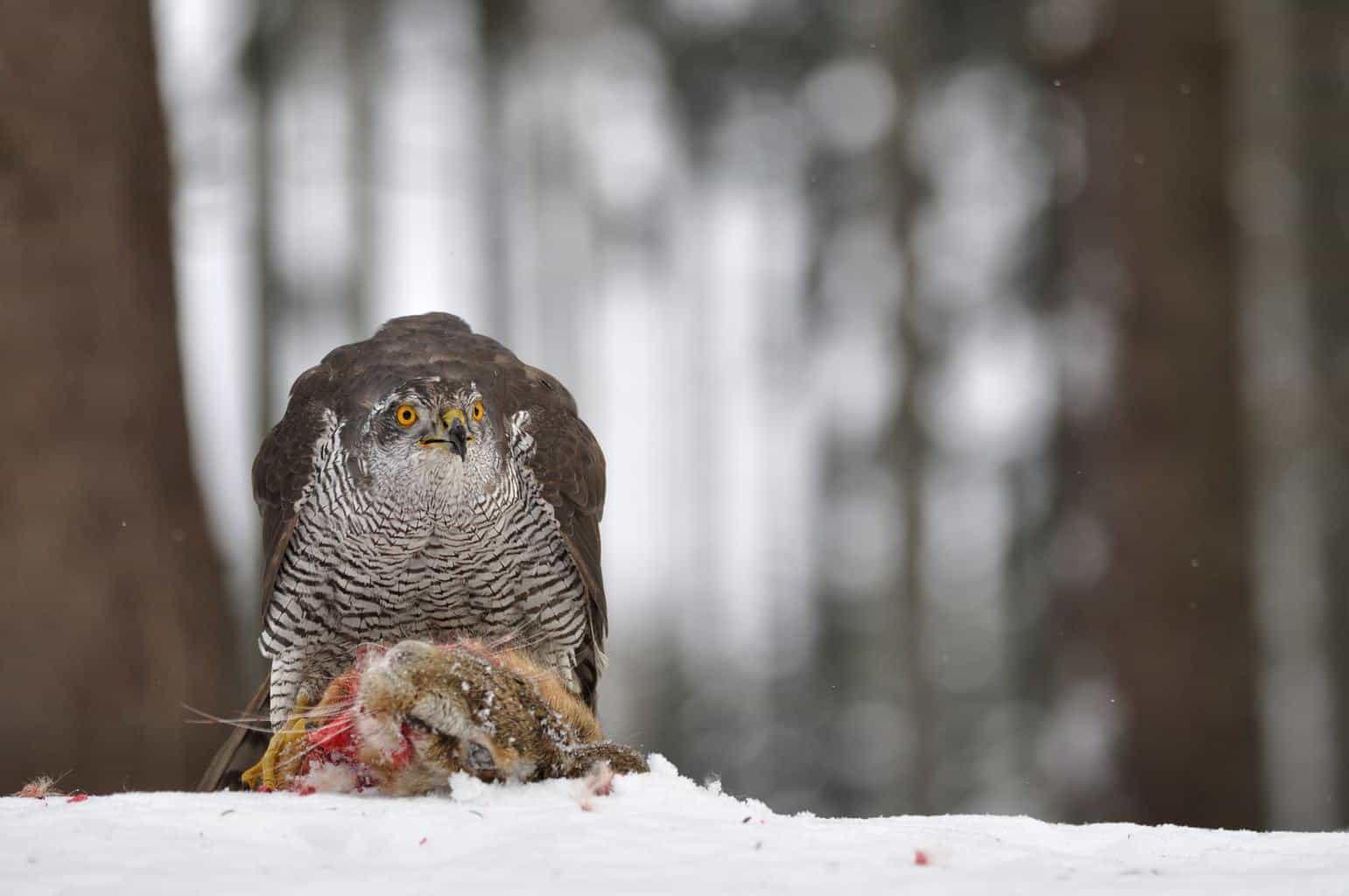
- Scientific Name: Accipiter gentilis
- Length: 16-27 inches
- Weight: 22–48 ounces
- Wingspan: 40.5–46 inches
Northern Goshawks are the only hawks that nest all over New Hampshire throughout the year. But because they are secretive birds, they like to stay hidden inside coniferous forests, only an experienced bird watcher can track them down.
Immature Northern Goshawks have streaky brown plumage and yellow eyes. The upperparts will turn dark slate gray on mature males while the underparts will become pale gray.
If you manage to see a Northern Goshawk, you’d better keep your distance! These hawks are among the most aggressive and defensive birds of prey. They can hunt larger prey and they often kill ducks by drowning them underwater — thank goodness they visit our backyards!
Northern Goshawk will build up to eight nests in the same forest. They may move between these nests to explore new hunting grounds if they fail to catch prey in their current position.
Red-Tailed Hawk
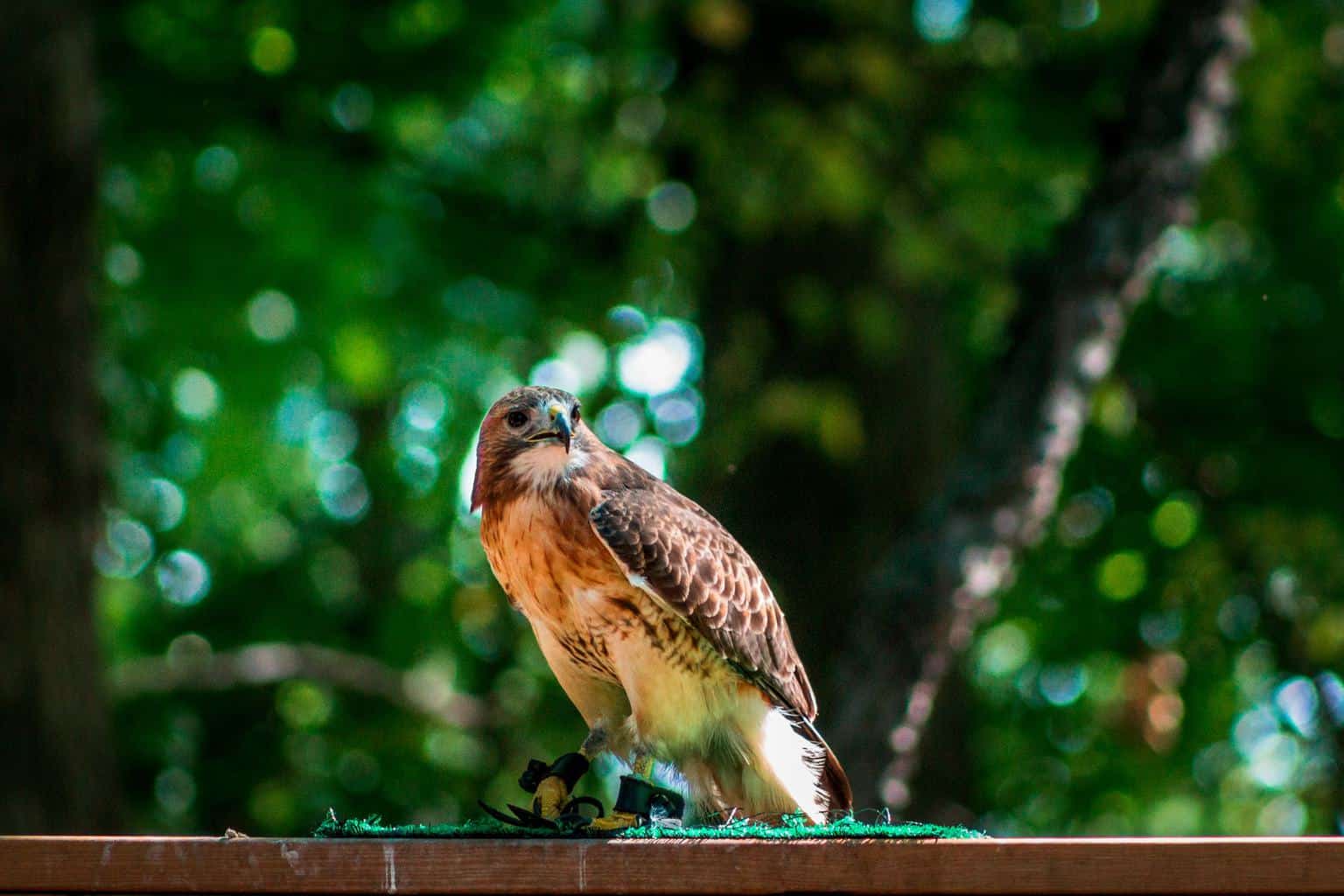
- Scientific Name: Buteo jamaicensis
- Length: 18–25.5 inches
- Weight: 24.5–46 ounces
- Wingspan: 45–52.5 inches
Because Red-tailed Hawks are the most common hawks in North America, you can spot them in many habitats, such as pastures, parks, rainforests, woodlands, mixed forests, and fields. They are also the second-largest hawk species. They particularly like to nest atop tall trees located along forest edges, which gives them a crucial advantage over their prey.
Mature birds have rich-brown upperparts, pale underparts, and cinnamon-red tails. While flying, they can be identified by their streaked belly and the dark band that spans across their shoulders.
You can still identify the Red-tailed Hawks by their unique raspy screams if you can’t see them. It’s such an epic sound that directors often associate it with fierce birds, like Bald Eagles in movies.
Red-tailed Hawks are year-round residents in the southern regions of New Hampshire. You may spot them in the north during the spring months, but they’ll migrate south when winter comes.
Sharp-Shinned Hawk

- Scientific Name: Accipiter striatus
- Length: 9.5–13 inches
- Weight: 3–8 ounces
- Wingspan: 17–22 inches
Sharp-shinned Hawks are among the most skillful hawk species. Known for their unparalleled agility, they are forest dwellers and often engage in high-speed pursuits through dense woods to catch their prey, typically songbirds.
If you spot one flying, you can quickly identify these hawks by the red-orange bars spanning over their chest. If these bars seem darker and coarser, that indicates an immature hawk. Both mature and immature Sharp-shinned Hawks have blue-gray upperparts, white underparts, rounded wings, and dark bands over their square tail. Their legs appear thinner than their bodies, which is the reason behind their name.
The Sharp-shinned Hawks live in southern New Hampshire throughout the year, but it’s not easy to spot them because they prefer to stay in deep forests. But, they like to migrate along ridgelines, so the ideal time to see them on top of the White Mountains is in the first months of fall.
Cooper’s Hawk
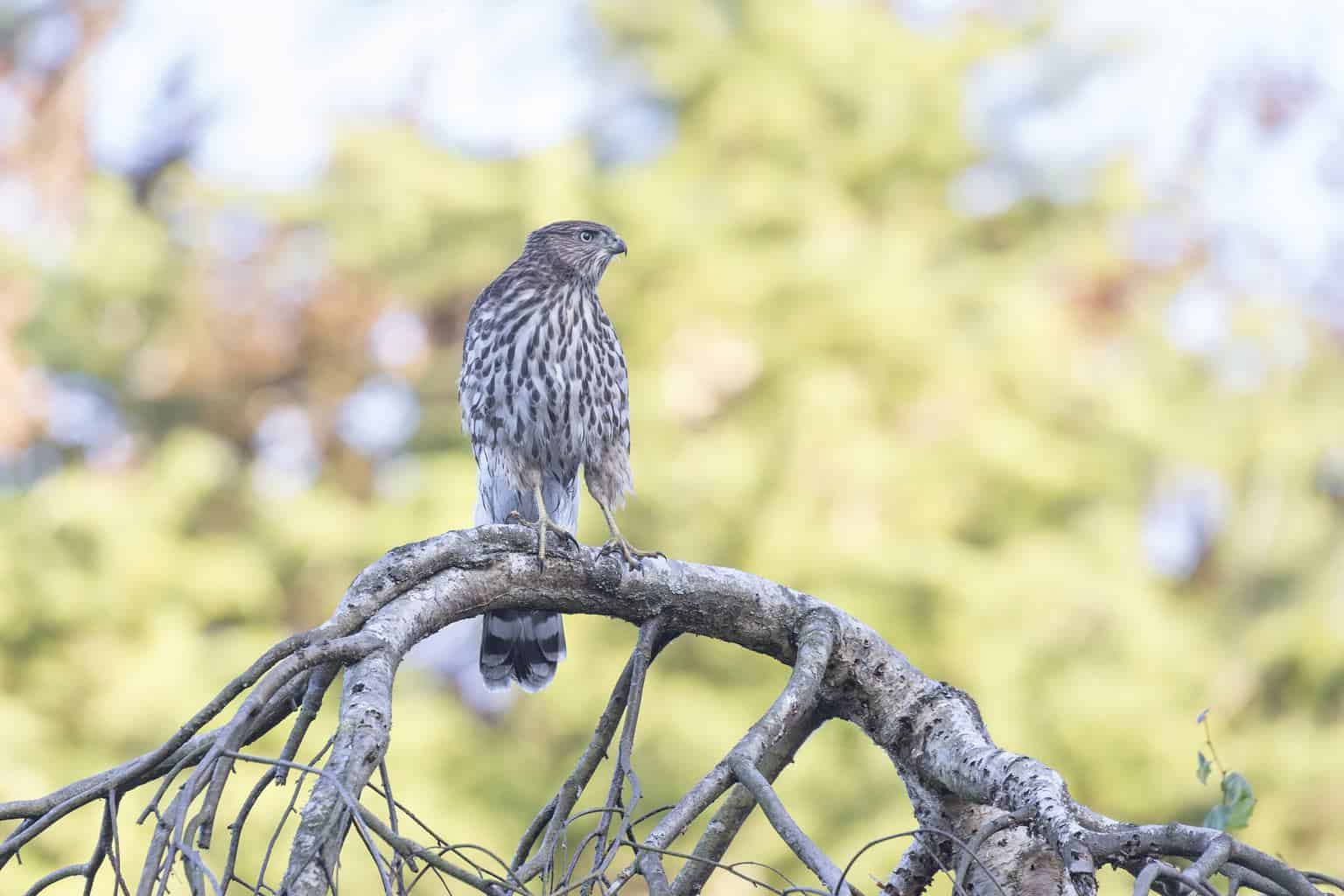
- Scientific Name: Accipiter cooperii
- Length: 14.5–15.5 inches
- Weight: 8–14.5 ounces
- Wingspan: 24.5–35.5 inches
Cooper’s and Sharp-shinned hawks look remarkably similar, with steely bluish-gray feathers on their upperparts and warm reddish underparts. Cooper’s hawks have a flatter head and rounded tail. The only other difference between these types of hawks is the size, as Coopers can grow twice as big as Sharpies.
However, if you’re looking at two immature hawks, they look like the same-sized birds. Plus, it’s not common to see both species perched next to each other, so the size isn’t a reliable identifying method.
Just like the Sharpies, Cooper’s Hawks like to dart through dense forests to catch unwary prey. Lately, they seem to have taken a liking to backyard bird feeders in suburban areas. They particularly like to hunt Blackbirds, European Starlings, and Mourning Doves.
When Cooper’s Hawks manage to catch prey, they won’t bite it directly like most raptors. Instead, they’ll choke the victim by squeezing it with their legs!
Cooper’s Hawks mainly live in the central United States, but they migrate north to New Hampshire in the summer months to mate.
Red-Shouldered Hawk
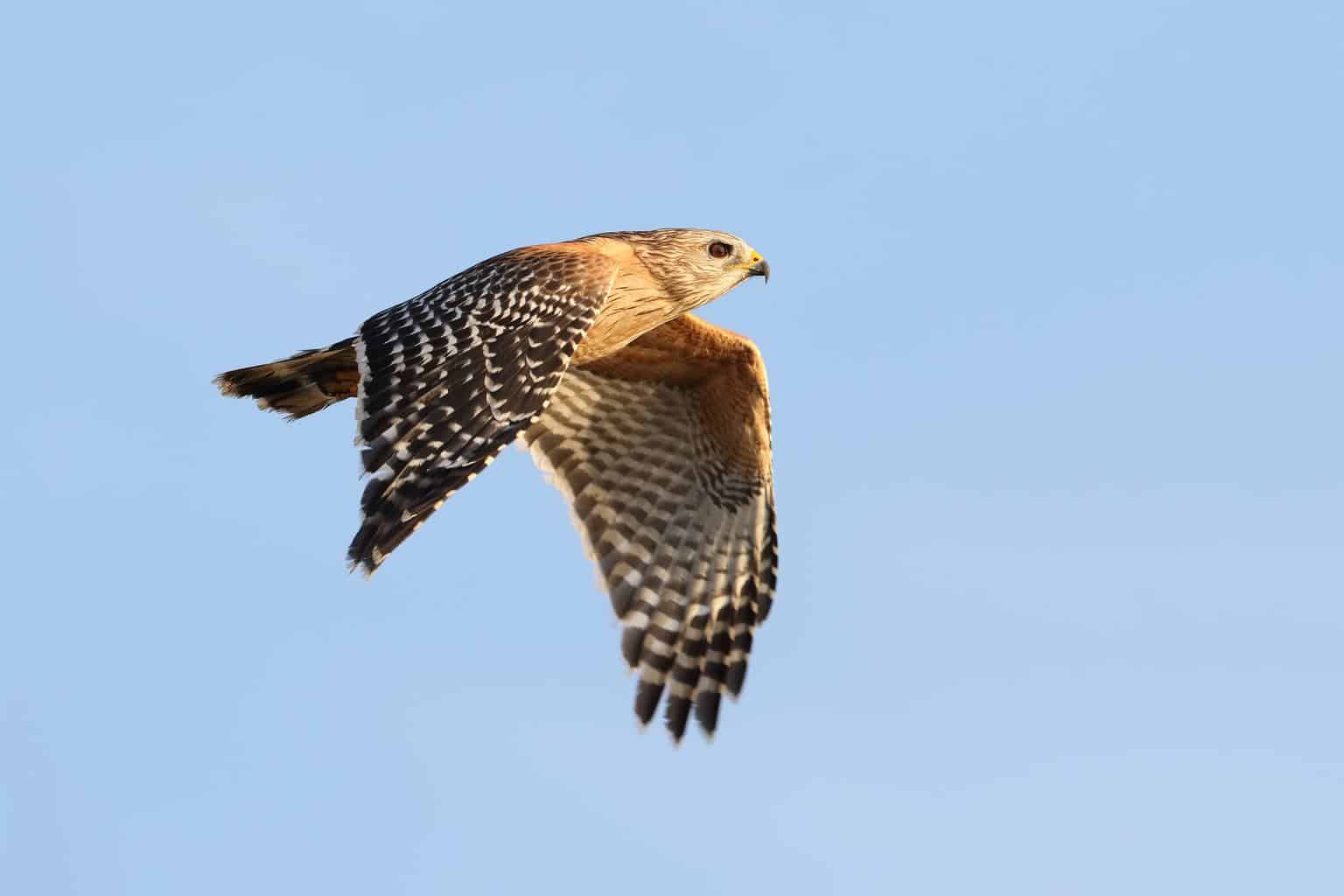
- Scientific Name: Buteo lineatus
- Length: 15-19 inches
- Weight: 17–27 ounces
- Wingspan: 35-50 inches
As the name implies, Red-shouldered Hawks have a wide warm-reddish band extending across their shoulders. The rest of their underparts are mostly pale with a reddish barring, while their upperparts are darker with a checkered pattern.
As these hawks soar high in the sky, you can identify them by the small pale crescents that border their wings.
To spot them, look in deciduous woodlands. They prefer nesting close to rivers and swamps because they feed on non-feathered prey, like amphibians and reptiles. They may also visit suburban forests to hunt small mammals, especially squirrels.
If you fail to identify them by their plumage, you can’t miss their distinctive calls. These hawks like to constantly sound their calls whenever they perch atop long poles or secluded trees. It’s also common to hear these calls from female hawks during breeding season as they take care of their hatchlings in the nest.
In New Hampshire, your best chance to spot these hawks will be in the spring — they’ll migrate south during the winter months since they can’t withstand the cold weather.
Broad-Winged Hawk

- Scientific Name: Buteo platypterus
- Length: 13.5–17.5 inches
- Weight: 9–20 ounces
- Wingspan: 32–40 inches
Despite the name, Broad-winged Hawks don’t have a broad wingspan. They were given this name because they have small, compact bodies that make their seemingly broad wings look broader than other birds of prey.
To identify these hawks, look for their reddish-brown upperparts, barred underparts, and black-and-white tail. Juvenile hawks will look similar, except that they’ll be slightly lighter.
Broad-winged Hawks are famous for migrating together in huge flocks, aka kettles. Some individual birds may go their own way, but after spending the spring and summer mating in New Hampshire, they migrate south to Mexico, Central America, and the Caribbean region.
To maximize your spotting chances, head to the Pack Monadnock Raptor Observatory between September 1 and October 31.
Although these hawks like to nest in forests, you may also see them perched close to backyards, open fields, and other open areas — that’s where they can use their excellent vision to locate their prey.
Northern Harrier
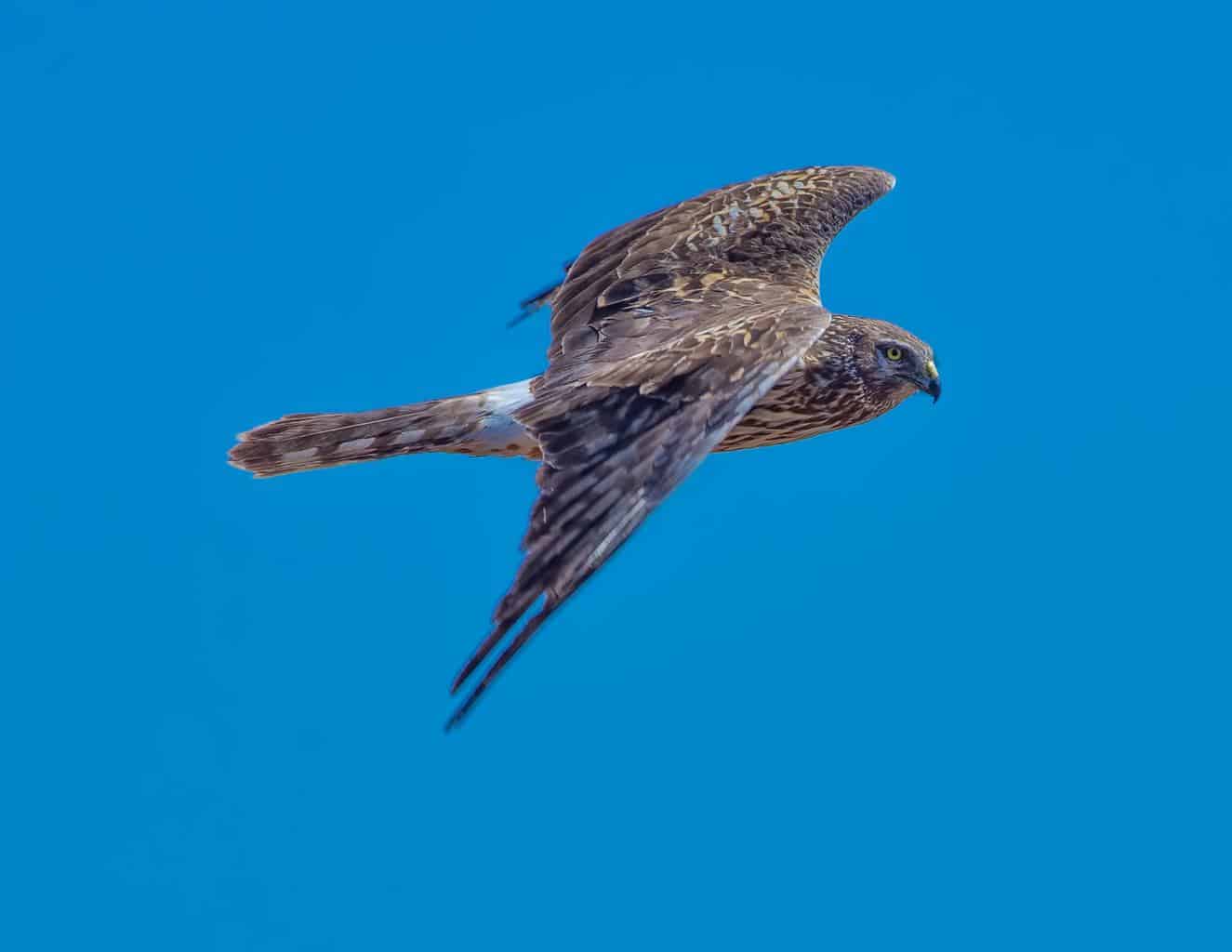
- Scientific Name: Circus cyaneus
- Length: 18–20 inches
- Weight: 10.5–26.5 ounces
- Wingspan: 40–46.5 inches
Despite the name, Northern Harriers don’t nest in the north — they’re indigenous to Mexico and the Caribbean islands. However, you can still spot them in the northern regions of New Hampshire during the spring and summer.
At first glance, some people may mistake Northern Harriers for owls. And to be frank, I used to do the same thing! These hawks have the same flat face and hooked bill as owls, and they even hunt by tracing the sound of prey rather than by sight.
Their most distinctive visual feature is their white rump. On adult birds, their bright underparts are especially evident while they perch on top of trees.
The rest of the upperparts are greyish, but it’s typical to see black feathers at the wingtips. The underparts may show light brown streaking in immature hawks, but it gets lighter in adult hawks.
Rough-Legged Hawk
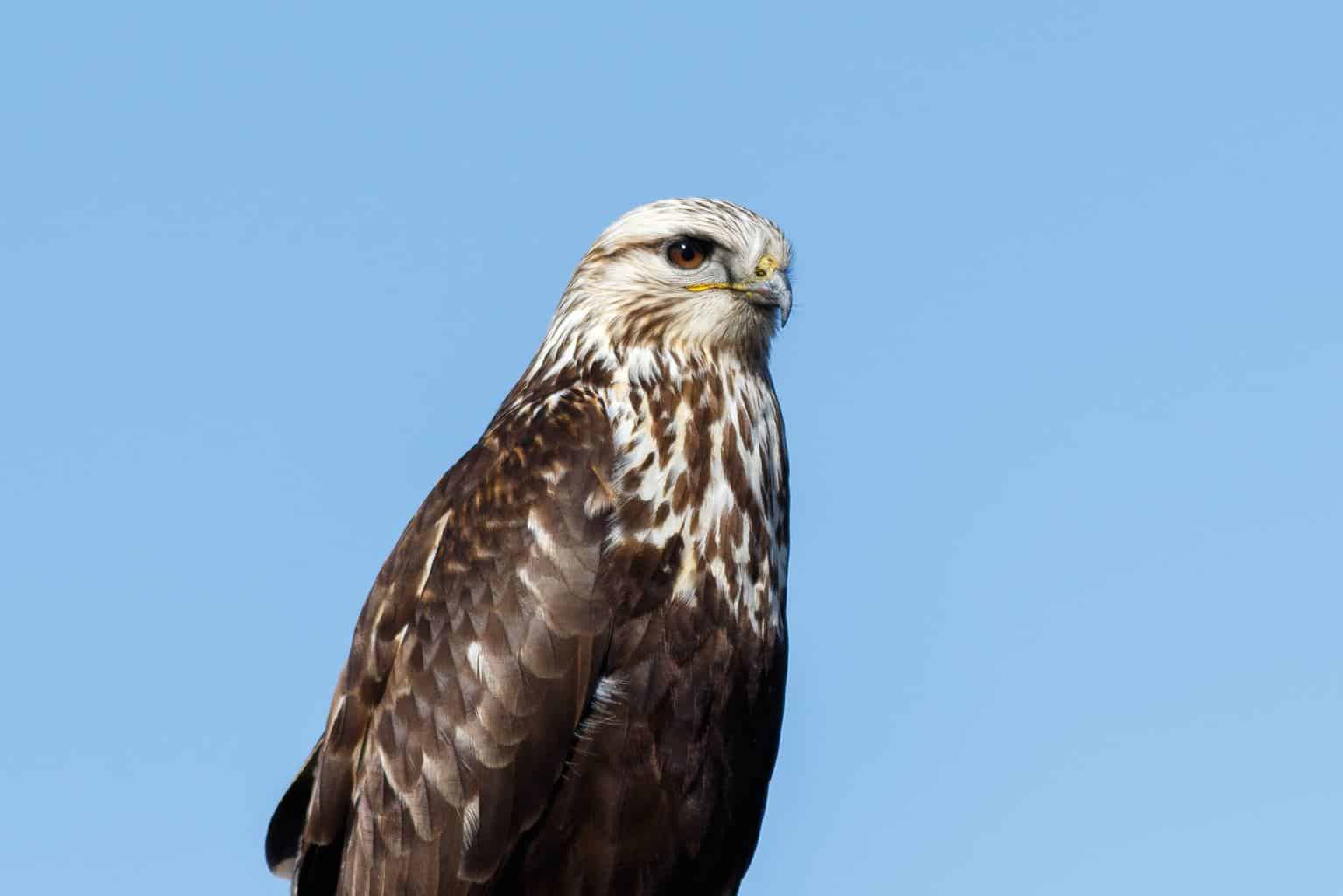
- Scientific Name: Buteo lagopus
- Length: 18.5–20.5 inches
- Weight: 25–49.5 ounces
- Wingspan: 52–54 inches
These medium-large hawks spend their summer mating in the Arctic region. If you’re wondering how they can withstand such extreme temperatures, it’s because their legs are covered in lush feathers — they’re the only hawks that have evolved this trait, which is why they’re named “rough-legged”.
But, those extra feathers are no match for the Arctic winter, and that’s why these hawks start migrating to New Hampshire in November. You’ll see them hunting in fields, farms, and pastures.
As these hawks soar up in the sky, you’ll be able to identify them by their distinctive M-shaped wings and the dark feathers located at the bend of the wing. You can also look for the dark band that spans across their belly.
To Sum Up
Sharp-shinned, Red-tailed, and Northern Goshawks are permanent year-round residents of New Hampshire. The other hawks on this list are spring and summer birds, except for the Rough-legged Hawk, which is a winter resident.
From spotting a Rough-legged hawk hanging out over the edge of fields of flowers to spying on a nesting pair of Broad-wing hawks in a forest, spotting a hawk at any time is a treat, but these are truly beautiful animals worthy of making the effort to find for the average bird watcher. And after you’ve had your fill of hawks, check out the 9 most common woodpeckers in New Hampshire!

